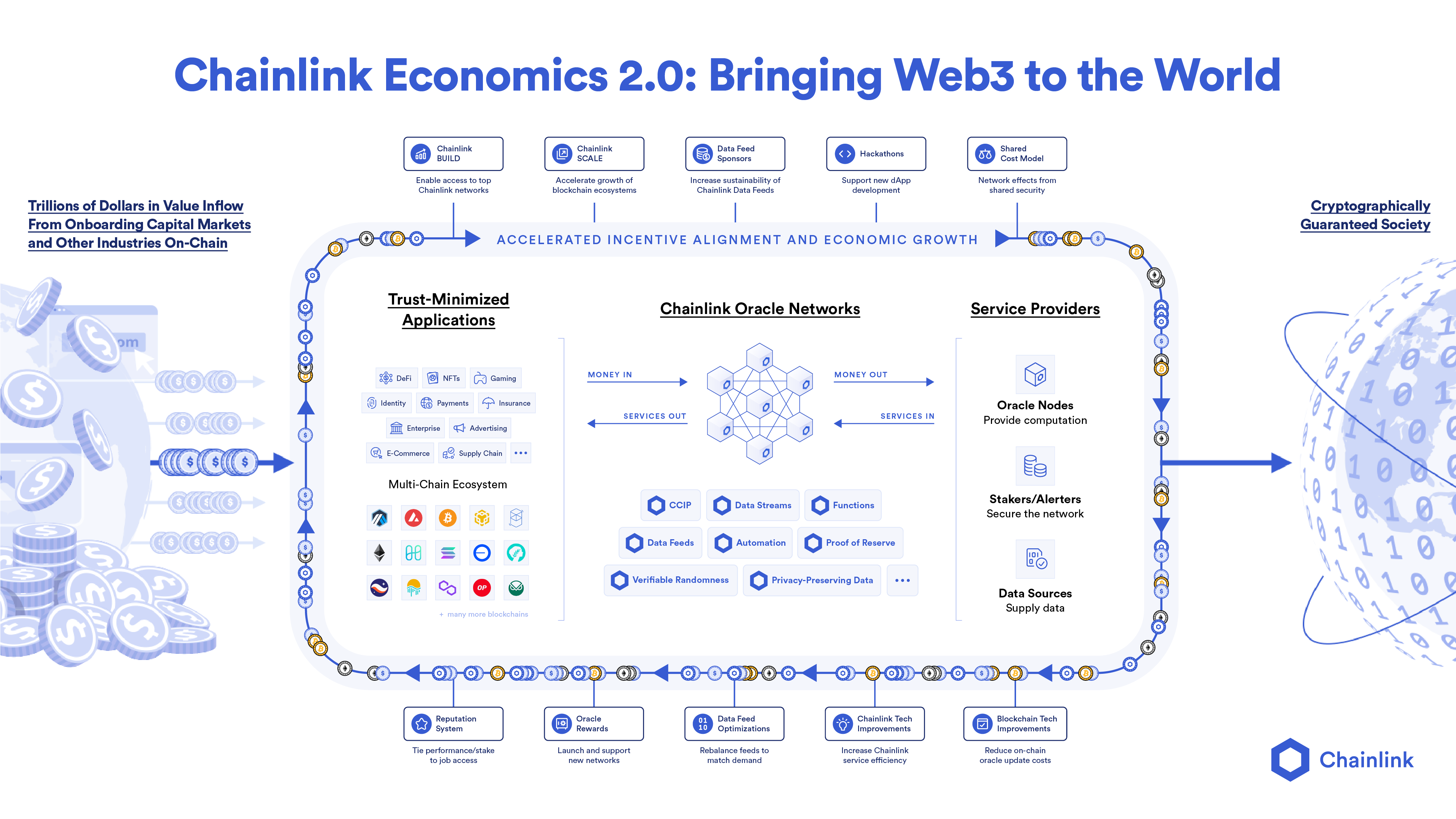Introducing Scale: Sustainable Chainlink Access for Layer 1 and 2 Enablement
Chainlink Labs is excited to announce Chainlink Scale—Sustainable Chainlink Access for Layer 1 and 2 Enablement—a Chainlink Economics 2.0 program centered around accelerating the growth of blockchain and layer-2 ecosystems while increasing the economic sustainability of the Chainlink Network.
Chainlink Scale allows blockchains and layer-2 networks to fast-track smart contract innovation in their native ecosystems by covering operating costs (e.g. transaction gas fees) of Chainlink oracle networks for a period of time. In doing so, their developers get access to a variety of important oracle services, which can include configurations specific to their ecosystem needs, such as Data Feeds with higher update frequencies to enable more advanced and low-latency smart contract applications.
To kickstart Chainlink Scale, a number of on-chain ecosystems—Avalanche, Metis, Moonbeam, and Moonriver—have confirmed their participation in covering certain oracle network operating costs and furthering R&D that helps unlock more advanced oracle features and solutions on their chains.
As blockchain ecosystems in the Chainlink Scale program mature, the operating costs of oracle networks can increasingly transition toward being fully covered by dApp user fees. This moves dApp ecosystems toward a holistic economic model that is more viable long-term for all participants:
- Blockchains help grow their dApp ecosystems so they can attract larger user bases and support a chain’s long-term cryptoeconomic security.
- Chainlink helps grow blockchains via oracle services so their dApp ecosystems can power real-world use cases that generate value.
- dApps have a runway to create sustainable fee-generation models based on real value-add services so they can eventually support the full backend costs of blockchain and oracle infrastructure through user fees.
Chainlink Scale is part of a more comprehensive initiative referred to as Chainlink Economics 2.0—an array of programs that focus on improving data security and utility while also reducing the operating costs of oracle services, increasing user fees that are paid to Chainlink service providers, and enabling a broader scope of service providers such as stakers to participate in the Chainlink ecosystem. To learn more about Chainlink Economics 2.0 and the evolution of LINK as a productive asset, visit chain.link/economics.

The Benefits of Chainlink Scale
Chainlink has become the industry standard oracle infrastructure for a wide variety of trust-minimized services, with a Transaction Value Enabled (TVE) of $6.18 trillion so far in 2022—a metric that measures the aggregate monetary value of transactions within a given time period. Oracle-powered transactions have been foundational to many early innovations in Web3, such as DeFi money markets, fair mint NFTs, and parametric crop insurance.

However, this innovation, powered by hybrid smart contracts, necessitates highly secure and reliable oracle infrastructure if a variety of exploits are to be avoided. As with any high-quality service, it comes with a cost. One of the most notable operating costs of oracle networks is on-chain transactions. Specifically, node operators incur a fee—commonly paid in the chain’s native coin—every time they deliver an oracle report on-chain.
Historically, these costs have been supported via oracle rewards paid to node operators, as well as user fees from dApps. Then, over time, as a dApp’s profitability surpasses an oracle network’s operation costs, oracle rewards can be reduced or eliminated entirely because the dApps consuming the particular oracle network generate sufficient user fees to support such costs. It’s a proven economic model for incentivizing a decentralized oracle node ecosystem, with some oracle networks on Polygon and BNB Chain already supported entirely by user fees.
Chainlink Scale (previously referred to as blockchain gas grants) is a complement to this economic model, where blockchains and layer-2 networks support the growth of their ecosystem through commitments of their resources, while user fees from dApps are still paid to generate long-term sustainability of the Chainlink DONs. Not only can participating blockchains and layer-2 networks increase developer access to key oracle services via Chainlink Scale, but they can support oracle networks with unique configurations that fit their chain’s specific needs and use cases.
Additionally, Chainlink Scale aims to reduce the operational complexity of Chainlink node operators as transaction fees in some cases can be paid in a chain’s native assets, which are needed to make on-chain transactions. A portion of the freed-up resources that would have been used as oracle rewards can then be redirected toward initiatives that further establish Chainlink’s network effect across more on-chain environments, more use cases, more service offerings, and more value capture opportunities.
Ultimately, Chainlink Scale aims to generate more economic value for each participant in Web3—blockchains, dApps, oracle service providers, and users—while also transitioning the entire stack toward a more sustainable economic model.
To learn more about Chainlink, visit the Chainlink website, subscribe to the Chainlink newsletter, and follow the official Chainlink Twitter to keep up with the latest Chainlink news and announcements.
—
Disclaimer: This post is for informational purposes only and contains statements about the future, including anticipated programs and features, developments, and timelines for the rollout of these programs and features. These statements are only predictions and reflect current beliefs and expectations with respect to future events; they are based on assumptions and are subject to risk, uncertainties, and change at any time, including the discontinuance of any announced program or feature without notice. There can be no guarantee that any of the contemplated programs or features will be implemented as specified nor any assurance that actual results will not differ materially from those expressed in these statements, although we believe them to be based on reasonable assumptions. All statements are valid only as of the date first posted. The statements in this post also may not reflect future developments due to user feedback or later events and we may not update this post in response.
